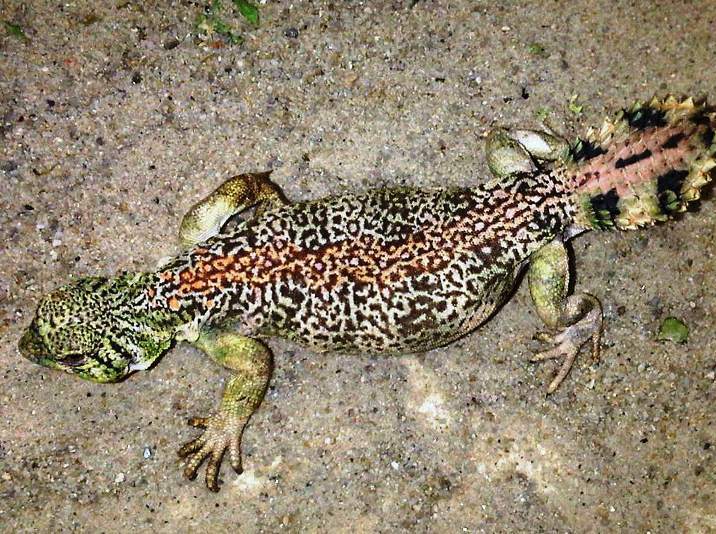
Uromastyx thomasi(Uromastyx thomasi)
Phylum —chordata
Class — reptilia
Order — squamata
Family — agamidae
Genus – uromastyx
Appearance
The total body length of these lizards does not exceed 26 centimeters, along with a short, wide tail. The tail is covered with 11-13 transverse rows of keeled scales.
The background color of the body is gray or olive or bluish, covered with small dark brown spots. A broad red-brown stripe runs along the spine, and the belly, chest, and inner sides of the limbs are yellowish-white.Females are more faintly colored. The coloration of males during sexual activity becomes brighter and more contrasting.
Habitat
Uromastyxthomasilive in a fairly limited area of the coastal areas of Oman.
Behavior
Uromastyxthomasiare found mainly on rocky and sandy plains with sparse vegetation, where the air temperature late in November in the period from 11:00 to 16:00 varies from 29.2 °C to 35.8 °C, and the ground surface temperature – from 37.5 °C to 51.1 °C. During the temperature peaks, representatives of the type Uromastyxthomasigo into burrows, the depth of which is from 20 to 41 cm, and the length from 45 to 165 cm.
Diet
They are mainly herbivorous lizards.
Reproduction
Their mating takes place at the end of February. The duration of pregnancy is 35 days. From May to September the females make several clutches of 9-16 eggs each. The duration of incubation is about 81-101 days, the length of young individuals after hatching is about 47 mm. Sexual maturity occurs around the 24-25 month of life.
In captivity
Lifespan in captivity is up to 20 years.
Enclosures for Uromastyx can include glass terrariums, commercial plastic cages, and outdoor pens. They should be given an area with a hot basking area and the other end of the enclosure should be kept cooler so the lizard can escape the intense heat and UVB if it needs to. Juveniles can be kept in 20-gallon long terrariums and larger individuals will require tanks in the 40 to 75-gallon range, depending on size of the individual.
Substrate: should be sterilized play sand or a mixture of ¼ peat moss and ¾ play sand. The key is for this substrate to remain dry. Damp substrate and even humidity inside the enclosure can cause the lizard to develop tail rot and other humidity-related health issues. A keeper should add a couple of shelters such as pieces of rain gutter or curled cork bark to provide the lizard an area to feel secure. Imitation rock caves work very well and add to the natural look of an enclosure. This shelter should be located at the end of the enclosure away from the intense heat. A shallow food dish (will contain the dry seed and bean mix) and a shallow water dish will complete the Uromastyx setup.
As desert-dwelling lizards, Uromastyx are adapted to hot, dry conditions. Their enclosure should include a basking area that reaches a daytime high in the 100º to 120ºF range. They must, however be able to get out of this heat. A long enclosure can easily provide this ability for the lizard to thermoregulate (choose the temperature it needs). Bulbs should be chosen that emit UVB rays in addition to heat. UVB rays are important for all diurnal (active during the day) lizards being kept indoors. Uromastyx benefit greatly from not only heat but the absorption of these rays. Night temperatures should be less than the daytime temperatures. We recommend night temperatures in the 60s to 70s oF.
Most Uromastyx species obtain moisture from the food they eat. We recommend providing a shallow water dish about the size of a petri dish or mayonnaise jar lid. This water should be purified or dechlorinated. Small Uromastyx will often drink from rocks and wood in their enclosures when they are sprayed with water. We suggest only doing this once or twice a month to avoid raising the humidity of the enclosure.
Uromastyx are herbivorous. Some care sheets suggest that young Uromastyx should be fed insects such as crickets, wax worms, and mealworms. Uromastyx fed on these insects show amazing growth but there is growing evidence that this high-protein diet may prove detrimental (and even fatal) for Uromastyx. We feed all sizes of Uromastyx a salad made of a mixture of romaine lettuce, Greenleaf lettuce, shredded sweet potatoes, carrots, peas, corn, and green peas. We also keep a shallow dish of white millet and a dry mix of split peas, lentils, and a variety of crushed beans in the enclosure at all times. In addition, dandelion greens, alfalfa, grass, and flowers can be added their diet when these plants are available. We sprinkle a mixture of 1/3 calcium and 2/3 high-quality reptile vitamins on the salad every third or fourth salad. Nutrition-related problems can occur if the lizards are not offered a healthy and varied diet with the proper supplementation. Growth can be stunted and metabolic bone disease can develop in these lizards, causing them to be disfigured or killing them.
 Russian
Russian
 English
English























